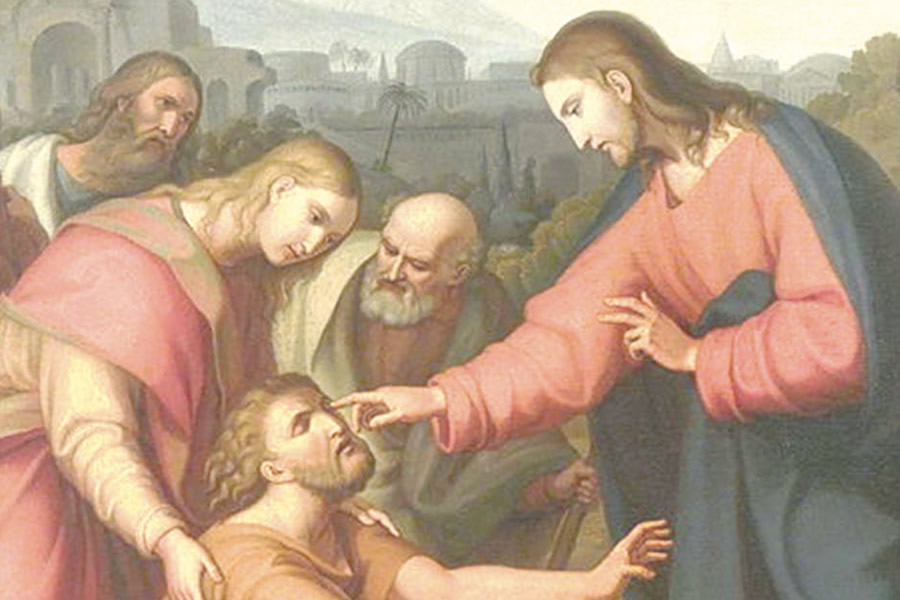Blog & Pastor Letters

Fourth Sunday of Lent
03-19-2023Weekly ReflectionFr. Edward LintonIn the first reading from the book of Samuel, we hear that Samuel was instructed by the Lord to go to the house of Jesse. There, the Lord would choose one of Jesse’s sons to replace Saul as the anointed king of Israel. One by one Jesse’s sons were brought in to stand in front of the prophet.
Each son seemed to have all the physical traits that one would expect for a king. And looking at each, Samuel thought, “Surely this one is the one.” However, after each of the seven sons came before Samuel, the Lord said, “Do not judge from his appearance or from his lofty stature, because I have rejected him. Not as man sees does God see, because man sees the appearance, but the LORD looks into the heart.”
Finally, Samuel asked Jesse, “Do you have any other sons?” To which Jesse replied, “Yes, there is still the youngest, who is tending the sheep.” So the youngest son, David, was brought in before Samuel. Having just made the point that God doesn’t see as humans see, it is interesting that Scripture reports that “David was ruddy, a youth handsome to behold and made a splendid appearance.” It seems, after making such as strong point that humans don’t see as God sees, that the writer of the Scripture would have said something like, “He was young and small and nothing much to look at, but the Lord saw something special in him!” But the Scripture doesn’t say that. It says that David made a splendid appearance. It seems that while it is true that humans don’t see as God sees, it may also be true that God sees as humans see. Or, put another way, it is possible for us to see as God sees.
How do we see as God sees? How is it possible to see as God sees? What kind of work do we need to do to see as God sees?
Many of us are familiar with Michelangelo’s statue of David which stands boldly in Florence. Michelangelo’s statue stands tall. David is portrayed having a body that is strong and muscular. He is self -possessed and sure of himself. Certainly, Michelangelo’s was not the first statue of David that had appeared in Renaissance Florence. Statues of David that were produced before Michelangelo’s portrayed him as having a slender, un-muscular body.
One statue portrays David picking up the sword of Goliath and you are left asking yourself, “How did that kid pick up that sword?” The sword is as tall as he is! These earlier statues portrayed David as other people saw him. But Michelangelo portrayed David as God saw him: full of faith, full of possibility, full of potential to do God’s will. This is the way of seeing to which God calls each of us. When we look at one another, we are not to look at the other’s sin, but their possibility to do good.
To see as God sees requires that we radically believe that God’s goodness is in every person. To see as God sees requires that we abandon anything in us that might get in the way of encouraging another’s goodness, whether that is jealousy, anger, or fear.
When I was a college student, I took a class in public speaking. The teacher was remarkable for always noticing the potential in us. Sometimes, when students would rise to give a speech or to read publicly, they would stutter or mispronounce words because they were so nervous. But no matter how horribly the student performed, this teacher would always find something positive on which to compliment the student. Then he would say, “And if you want to make that even better, then you might consider this or that.” He didn’t berate the student at all. He taught by building on the foundation of what was good. He understood that his role as a teacher was to help students recognize their talents and help the improve on them. It seems that this is a real Christian approach. We are not to berate people for their sinfulness, like the chief priests berated the blind man. We are to recognize the potential of every person to follow Christ. Just as Jesus gave sight to the blind man, so Jesus gives us sight. Jesus gives us sight to recognize the potential in others to follow Christ even more closely.
The Good News is that Christ shows us how to see as God sees!
BACK TO LIST